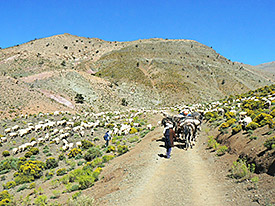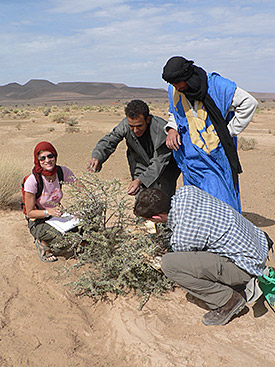Press release from 15 July 2014
Socio-economic change more of a problem for nomads than climate change
Study on the impacts on livestock farming in arid regions
Leipzig. Socio-economic change could have a much bigger impact than climate change on grazing lands in the world’s arid regions. This is the conclusion reached by scientists from the Helmholtz Centre for Environmental Research (UFZ) and the University of Cologne, who simulated ecological and social factors in a computer model. The negative effects of climate change can to a certain extent be offset by an increased herd mobility, write the researchers in a recent issue of the journal Global Environmental Change. However, higher income demands and less available grazing land make it increasingly difficult for nomads to move their herds around to secure their livelihoods.

Nomadic Berber herdsmen from the ethnic group of the Aїt Toumert move their herds to their summer pastures in Morocco’s High Atlas. Access to these productive pastures is strictly regulated among Berber groups.
Photo: Dr. Gisela Baumann/University of Cologne

Pastoral nomads in Morocco’ south-eastern drylands have an impressive ecological knowledge on the quality and availability of forage plants on their pastures.
This traditional knowledge is essential for their mobility decisions (left: Dr. Anja Linstädter, rangeland ecologist at the University of Cologne and co-author of the publication in
„Global Environmental Change“ during an interview with local herdsmen).
Photo: Dr. Gisela Baumann/University of Cologne
Arid and semi-arid regions of the world account for around 40 per cent of earth’s land surface. The main source of income in these regions is livestock farming, which supports over a billion people. Since rainfall in these regions is low and irregular, many nomadic peoples have adapted their way of life and move their herds to wherever the vegetation offers the best grazing at the time. In doing so they also rest some parts of their grazing land, which is given a chance to recover – a positive ‘side-effect’ of mobility. Changing climate conditions, such as bigger rainfall fluctuations, could disrupt this sensitive system. For instance, some parts of north-west Africa are predicted to see a 10 to 20 per cent decrease in rainfall levels. The study therefore aimed to identify climate change limits, within which the livelihoods of households that depend on livestock could be maintained in the long term. The researchers also looked at socio-economic changes, combining a risk assessment with an environmental and economic model.
The evaluation showed that higher fluctuations in annual rainfall sums would have less of an impact on animal farming than a decrease in average levels of annual rainfall. Socio-economic changes, such as higher income requirements, raised the tolerance limits for rainfall fluctuations. “To a certain extent, mobility enables nomads to continue their pastoral farming practices in less productive systems, thereby offsetting negative effects of climate change,” reports Dr Romina Martin of the UFZ, who is now conducting research at the Stockholm Resilience Centre. However, higher income requirements and less access to grazing land make it increasingly difficult to maintain this mobility.
“Although our model focuses on nomadic grazing systems and only considers the most important drivers, it reflects the consequences of the dramatic change in land use patterns in arid regions,” says Prof. Karin Frank of the UFZ. “However, our approach is not restricted to studying grazing systems. It can be used anywhere where the dynamics of ecosystem services are closely linked to people’s livelihoods.”
“Our results emphasize the fact that the form of pastoralism practised by nomadic herdsmen enables sustainable use of sensitive ecosystems and that the ecosystems are resilient enough, when used in this way, to adapt to changes in rainfall and therefore to climate change,” says Dr Anja Linstädter of the University of Cologne. Dr Birgit Müller of the UFZ adds: “So we should not simply dismiss nomadism as an outdated tradition.” In many arid regions this could be the only sustainable form of land use – unlike intensive crop farming, which enables higher yields in those regions, but over-uses the soil and water resources to such an extent that agriculture soon stops being viable. In the authors’ view, this also casts a different light on the discussion about what, to western eyes, appears to be unused land in many parts of Africa. In reality, this communal grazing land represents an important basis for subsistence for local populations.
The study incorporated research findings from field studies conducted in Morocco’s Atlas Mountains and Oriental region, and in the highlands of Tibet, as part of two interdisciplinary projects. Under the umbrella of the IMPETUS project at the Universities of Cologne and Bonn, Germany, climatologists, hydrologists, geographers, rangeland ecologists and ethnologists spent 12 years investigating the consequences of climate and land use change on natural resources in the High Atlas Mountains in Morocco. Their data on rainfall fluctuations and on the productivity and regenerative capacity of pasture vegetation formed the basis for the ecological part of the model. By contrast, the Collaborative Research Centre for Difference and Integration at the German Research Foundation (DFG) focused on investigating the lives of nomadic peoples in the “Old World dry belt”. Archaeologists, ethnologists, geographers, historians and orientalists at the Universities of Halle and Leipzig, Germany, collaborated with colleagues from other institutes on this project for more than ten years because nomadic and settled cultures have existed side-by-side between Morocco and Tibet for over 5000 years.
Some unconventional methods have since been used to disseminate the findings: within the DFG’s Collaborative Research Centre for Difference and Integration, UFZ scientists worked with the Berlin
University of the Arts (UdK) to develop a strategic game to explain the connections between land use, rainfall and livestock capital to a broad public. In the game, up to six players take on the
role of a nomadic herdsman. The aim is to increase the herdsman’s capital in the form of sheep. Players have to take decisions that depend not only on the state of the grazing land, but also on
the day-to-day challenges of life in the steppes. The NomadSed board game is suitable for ages ten and over and is now also being used for development education, e.g. by the “Vétérinaires Sans
Frontières Germany” in Kenya.
Tilo Arnhold
Publication
Martin, R., Müller, B., Linstädter, A., Frank, K. (2014):
How much climate change can pastoral livelihoods tolerate? Modelling rangeland use and evaluating risk. Global Environmental Change 24, 183–192.
http://dx.doi.org/10.1016/j.gloenvcha.2013.09.009
The study was funded by the German Research Foundation (DFG, project SFB 586 ‘‘Difference and Integration’’), the German Ministry of Education and Research (BMBF, project IMPETUS) and the Helmholtz Association.
Further informationen
Prof. Dr. Karin Frank, Dr. Birgit Müller
Helmholtz Centre for Environmental Resaerch (UFZ)
Telephone +49-(0)341-235-1279, -1708
Prof. Dr. Karin Frank
Dr. Birgit Müller
Dr. Romina Martin (geb. Drees)
Helmholtz Centre for Environmental Resaerch (UFZ), z.Z. am Stockholm Resilience Centre
Telephone +46 76 70 60 676
Dr. Romina Martin
www.stockholmresilience.org/21/contact/staff/9-12-2013-martin.html
Dr. Anja Linstädter
University of Cologne Köln
Telephone +49-(0)221-470-7905
Dr. Anja Linstädter
or
Helmholtz Centre for Environmental Resaerch (UFZ)
Tilo Arnhold, Susanne Hufe (UFZ Press office)
Telephone +49-(0)341-235-1635, -1630
Further links
DFG SFB 586 "Difference + Integration"
www.nomadsed.de/home/
Project IMPETUS
www.impetus.uni-koeln.de/projekt.html
Helmholtz Graduate School HIGRADE
www.ufz.de/higrade
In the Helmholtz Centre for Environmental Research (UFZ), scientists conduct research into the causes and consequences of far-reaching environmental changes. Their areas of study cover water resources, biodiversity, the consequences of climate change and possible adaptation strategies, environmental technologies and biotechnologies, bio-energy, the effects of chemicals in the environment and the way they influence health, modelling and social-scientific issues. Its guiding principle: Our research contributes to the sustainable use of natural resources and helps to provide long-term protection for these vital assets in the face of global change. The UFZ employs more than 1,100 staff at its sites in Leipzig, Halle and Magdeburg. It is funded by the federal government, Saxony and Saxony-Anhalt.
The Helmholtz Association contributes to solving major and urgent issues in society, science and industry through scientific excellence in six research areas: Energy, earth and environment, health, key technologies, structure of matter as well as aviation, aerospace and transportation. The Helmholtz Association is the largest scientific organisation in Germany, with 35,000 employees in 18 research centres and an annual budget of around €3.8 billion. Its work is carried out in the tradition of the great natural scientist Hermann von Helmholtz (1821-1894).
